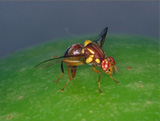Queensland Fruit Fly
Pest Profile

Top Photo G.T. O'Loughlin, Department of Agriculture, Bugwood.org
Left Photo from Pest and Diseases Image Library, Bugwood.org

The adult female QFF is approximately 6 mm in length, it has a wing expanse of 10 to 12 mm, and it has transparent wings. Body coloration is brown marked with yellow. The dorsum of the thorax has a broad creamy band with a narrow yellow stripe on either side. The abdomen is constricted at the base, and broadly rounded at the tip.
History and Economic Importance
The QFF is an invasive insect originating in Australia. It has been accidentally introduced into New Zealand, where it was successfully eradicated. QFF feeds on many types of fruits and vegetables. Important California crops at risk include pome and stone fruits, citrus, dates, avocados, and many vegetables, particularly melons and tomatoes. Damage occurs when the female lays eggs in the fruit. These eggs hatch into larvae, which tunnel through the flesh of the fruit, making it unfit for consumption. The first California detection occurred in San Diego County in 1985, and it was found again in Orange County in 1991.
Distribution
In Australia, QFF is present in the States of New South Wales, Queensland, South Australia, and Victoria.
Life Cycle
The pre-ovipositional period for adult QFF averages two weeks. Up to seven eggs are laid in a group in fruit punctures. As many as 40 larvae have been found in one peach. Under favorable conditions, eggs hatch in 2 to 3 days. Larvae are fully grown in 5 to 7 days and emerge from the host material to pupate, typically in soil. The pupal stage lasts from a week in warm periods to a month or more in cooler periods. The total life cycle requires approximately 2 to 3 weeks in summer to 2 months in fall. Because adult females can live for prolonged periods, four or five overlapping generations can develop annually. Overwintering is in the adult stage. Adults feed on honeydew (a sugary fluid excreted by plant-feeding insects), decaying fruit, nectar, and plant sap. The adult is a strong flyer and can infest new areas very quickly.
Host and Damage
A number of commercially valuable fruits and vegetables are attacked by QFF (see Host List below). Fruit that has been attacked may be unfit for consumption due to the larvae tunneling through the flesh as they feed. Decay-producing organisms then enter, leaving the interior of the fruit a rotten mass.
